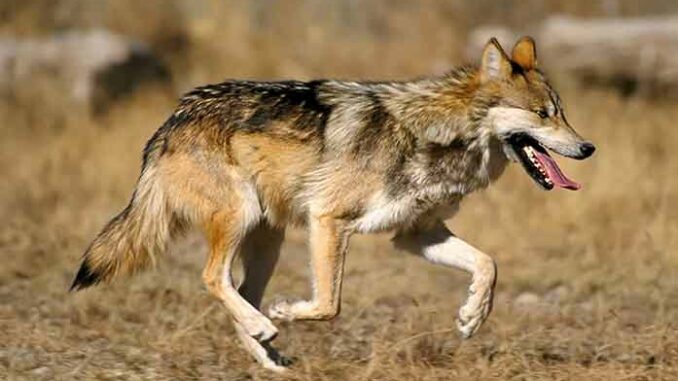
A new study, commissioned by the Pima Natural Resource Conservation District*, examined the genetics of Mexican wolves (Canis lupus baileyi) and assessed the possibility of hybridization with dogs of Native American origin and or/coyotes. You can read the entire study here.
The basic finding from this research and other research cited within the report are that all North American wolves are hybrids with coyotes, and a few are hybrids with dogs. The current captive-bred population of Mexican wolves shows no hybridization with coyotes or dogs, but some previous research did detect some Mexican wolf-coyote hybrids.
Here are some highlights from the report:
The study concluded “living Mexican wolves are not derived from hybridization with Native American dogs. The results also did not indicate recent hybridization between Mexican wolves and coyotes. However, one wolf-dog hybrid was detected in wolves from Idaho. Our study used captive-reared Mexican wolves, therefor future analyses of wild-born wolves and dogs living in the same areas are needed to determine if hybridization is occurring in the wild population of Mexican wolves in Mexico, New Mexico and Arizona.”
The report notes that other studies have found wolf-dog hybrids in northern wolves .
“A second hybridization concern involves wolves and coyotes. Wolves and coyotes share a recent common ancestor during the Pleistocene (Ice Ages) in North America and their subsequent occupation of the same ranges may result in some level of hybridization. Indeed, evidence of historic and recent hybridization comes from mitochondrial DNA (mtDNA) sequences, y-chromosome, SNPs and whole genome sequences (WGS).”
“… land use changes following European colonization of North America have favored the spread of coyotes while wolf populations have declined, resulting in substantial levels of hybridization between these two species in some areas (e.g. Eastern North America). This same process also resulted in hybridization with domestic dogs, contributing to three species hybrids in some populations…”
“..all North American wolves …have significant amounts of coyote ancestry. In addition, we detect a strong geographic cline in the proportion of coyote ancestry across North American canids: Alaskan and Yellowstone wolves have 8 to 8.5% coyote ancestry, Great Lakes wolves have 21.7 to 23.9% coyote ancestry, Algonquin wolves have at least 32.5 to 35.5% coyote ancestry, and Quebec sequences have more than 50% coyote ancestry. [A] Mexican wolf… had a coyote ancestry of approximately 11%. The significance of these results, as well as those of previous authors, is that wolf-coyote hybridization occurs naturally, and the process can be accelerated in human-dominated landscapes that favor coyotes.”
“The captive Mexican wolf samples were divergent from other wolves as well as coyotes and dogs of European, East Asian, and North American descent.”
“Additionally, the remnant Mexican wolf population was subject to, and has the genetic signal of, one of the most severe, recent genetic bottlenecks in conservation history. It was founded from just seven remaining individuals separated into three lineages, subsequently inbred in captivity, and then lineages cross-bred to attempt a genetic rescue.”
We see from this study that the science is not settled. There are still several outstanding questions regarding Mexican wolves in the wild.
Question for readers: Should an animal group that is variously hybridized with other animals qualify for protection under the Endangered Species Act?
*About the Pima Natural Resource Conservation District (link)
The Pima NRCD is a State-authorized local unit of government that has been given a broad mandate to provide for the restoration and conservation of lands and soil resources, the preservation of water rights and the control and prevention of soil erosion, and thereby to conserve natural resources, conserve wildlife, protect the tax base, protect public lands and protect and restore this state’s rivers and streams and associated riparian habitats, including fish and wildlife resources that are dependent on those habitats, and in such manner to protect and promote the public health, safety and general welfare of the people.
Arizona’s 42 Conservation Districts cover the entire state of Arizona, and parts of New Mexico and Utah on the Navajo Nation. Arizona’s Conservation Districts are in a unique position to lead local conservation partnership efforts that achieve landscape level results across all land ownerships in Arizona. They have authority to enter into agreements with private landowners, state and federal agencies, tribes, and others to implement a local conservation program in their District. The Conservation District model has proven itself over the last 75 years to be the most effective approach to achieving sound management of Arizona’s natural resources.
Pima NRCD believes private lands provide the tax base that supports most county and state services. Additionally, private lands are the underlying lands for historic federal and state grazing leases, as these lands are the basis for economic productivity.
Disclosure: I am a board member of Pima NRCD.
See also:
Note to readers:
If you like murder mysteries, type the name Lonni Lees (my wife) into Amazon or Barnes & Noble sites to see her novels, a book of short stories, and reviews. For synopses and more reviews of her books see: https://wryheat.wordpress.com/lonnis-murder-mysteries/
